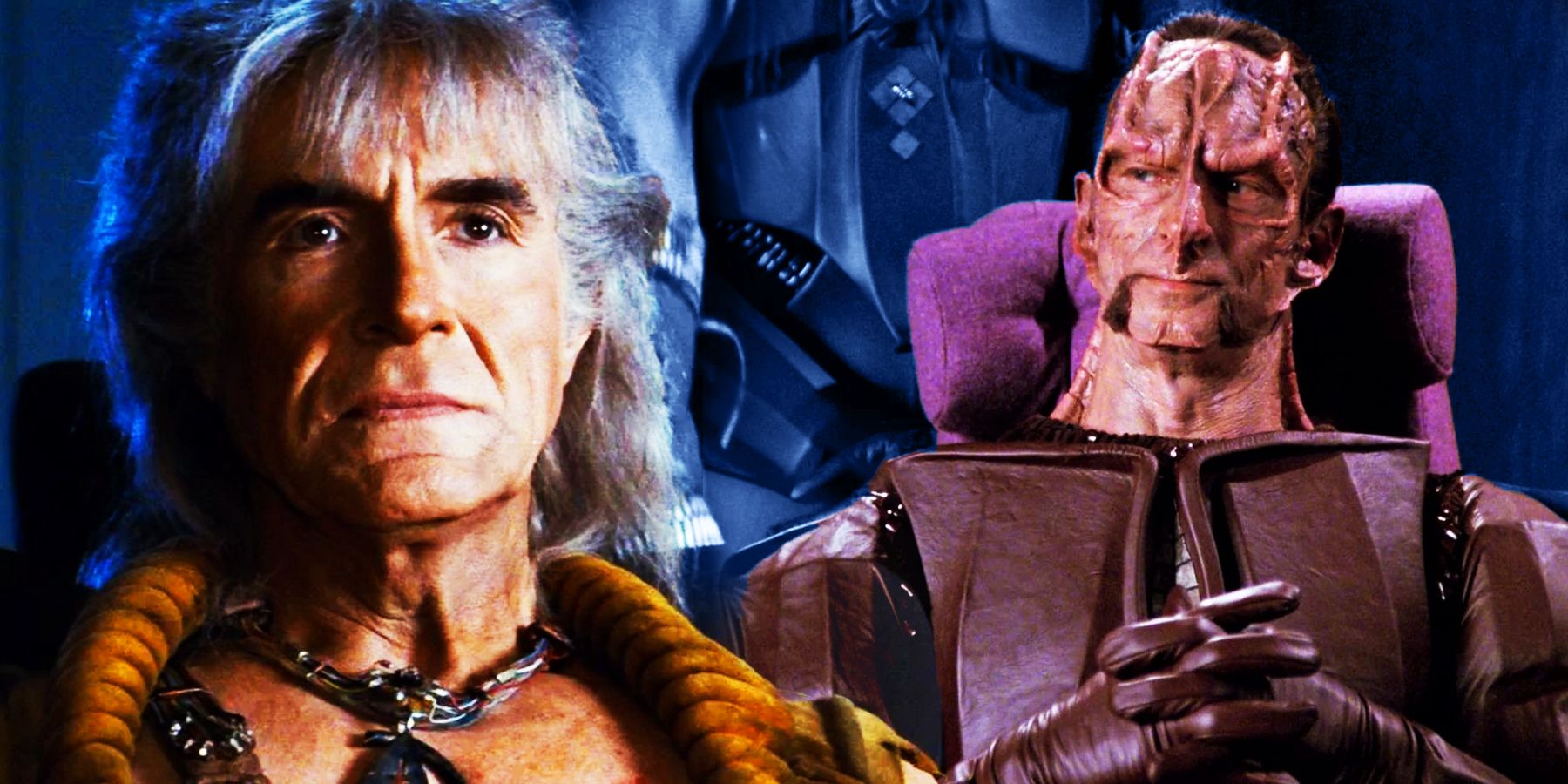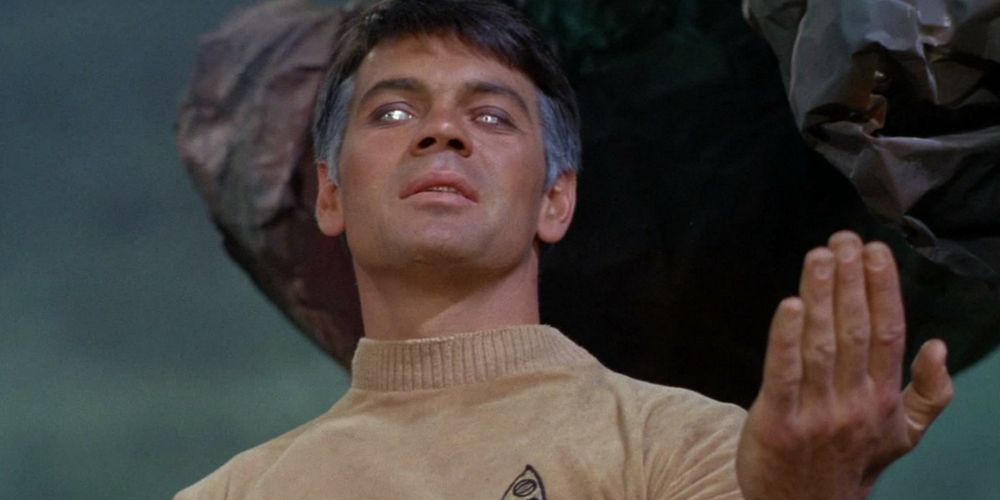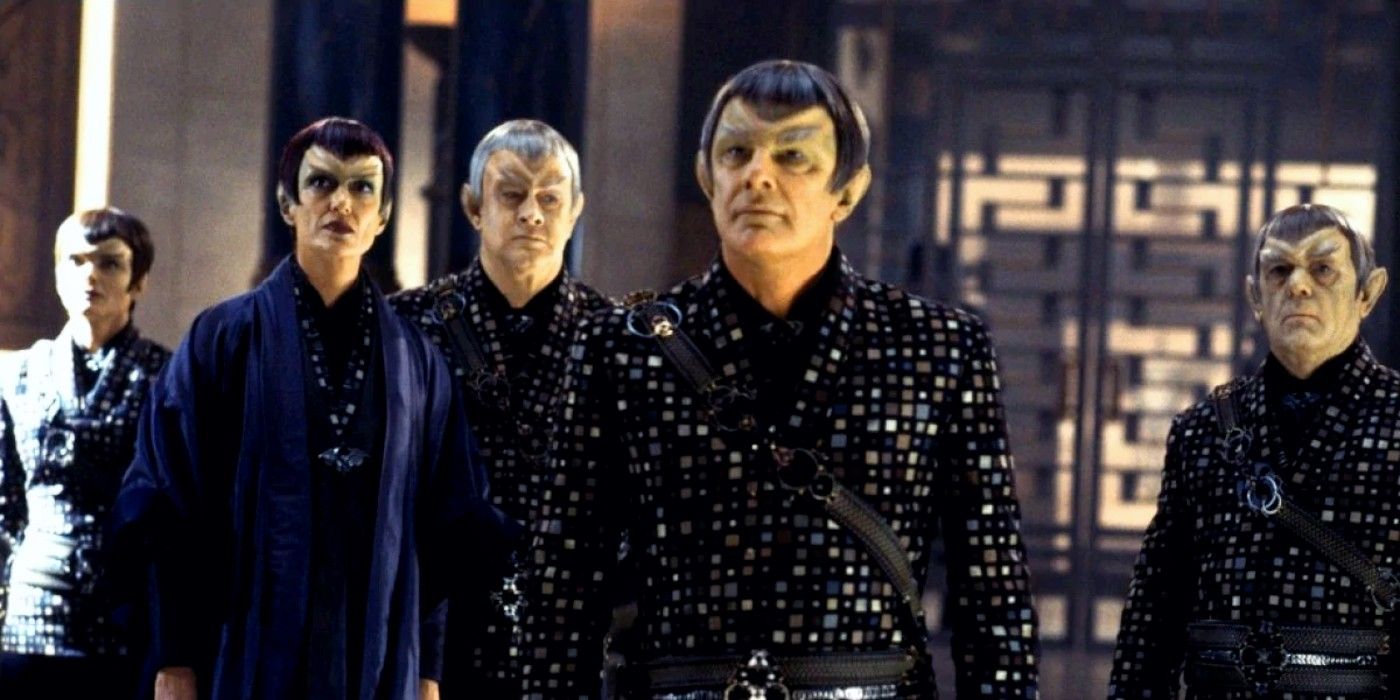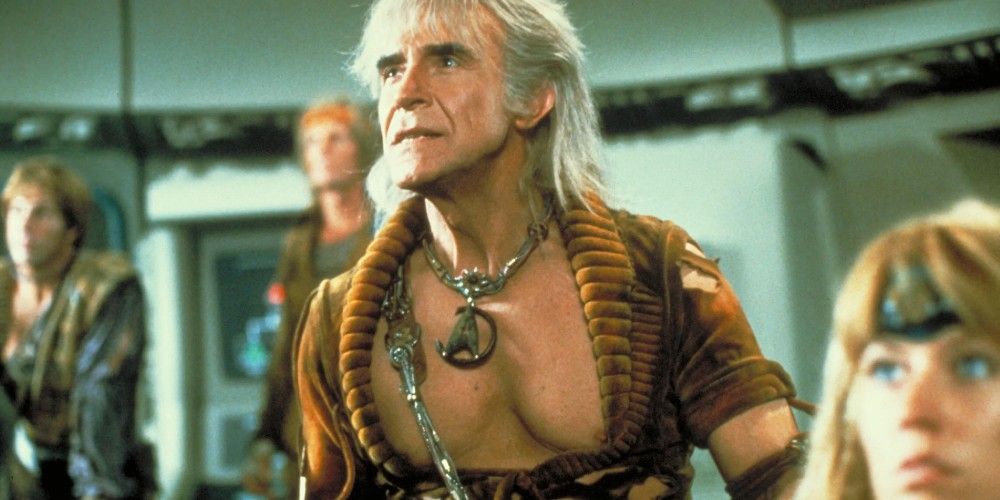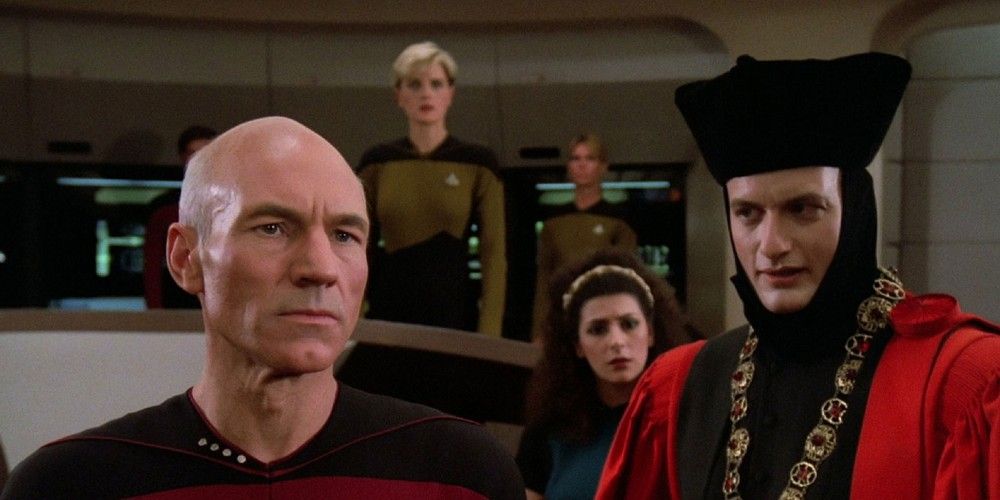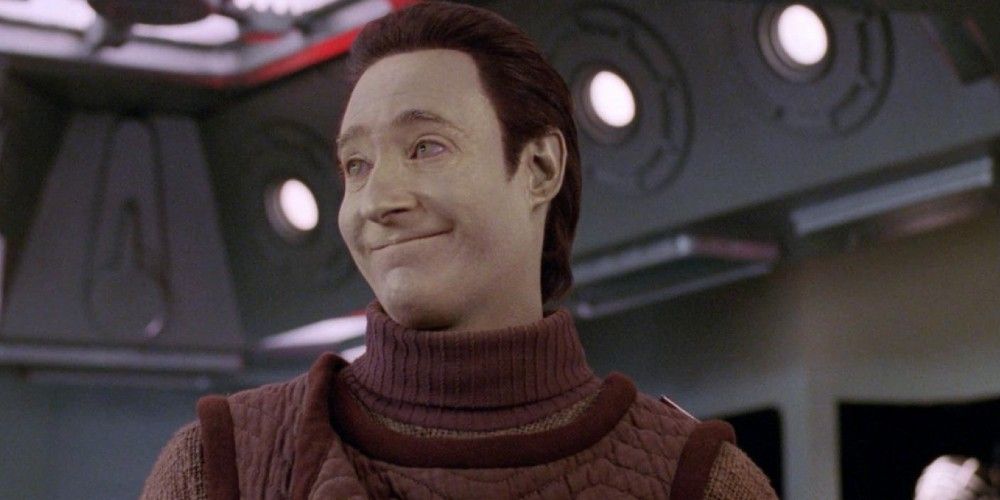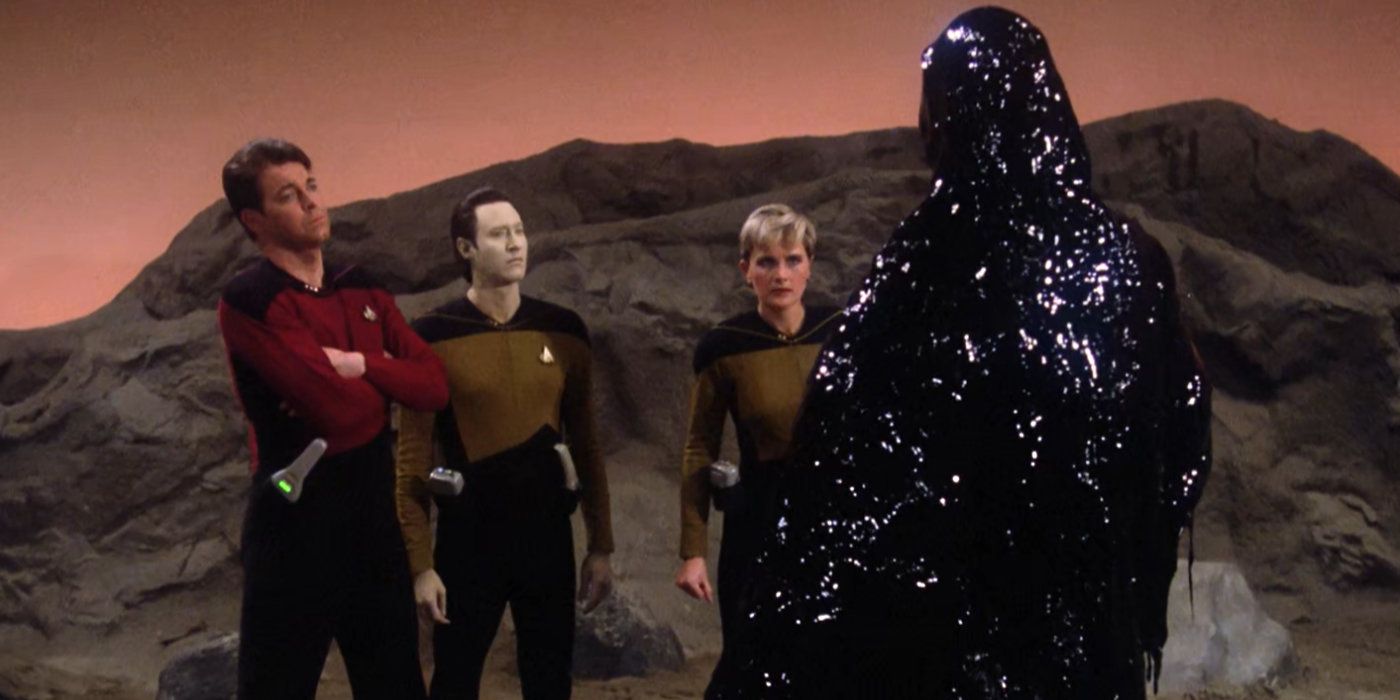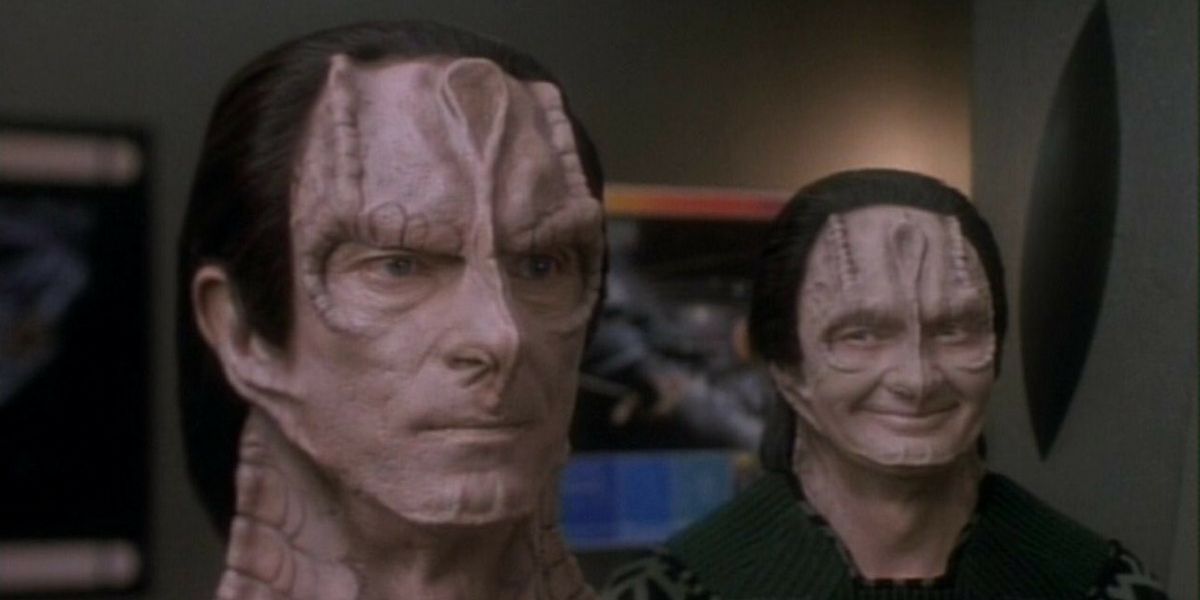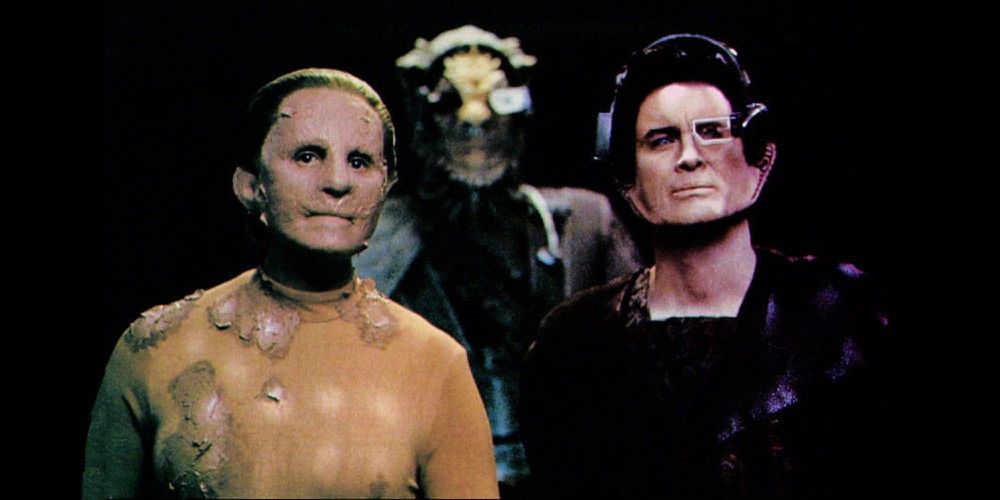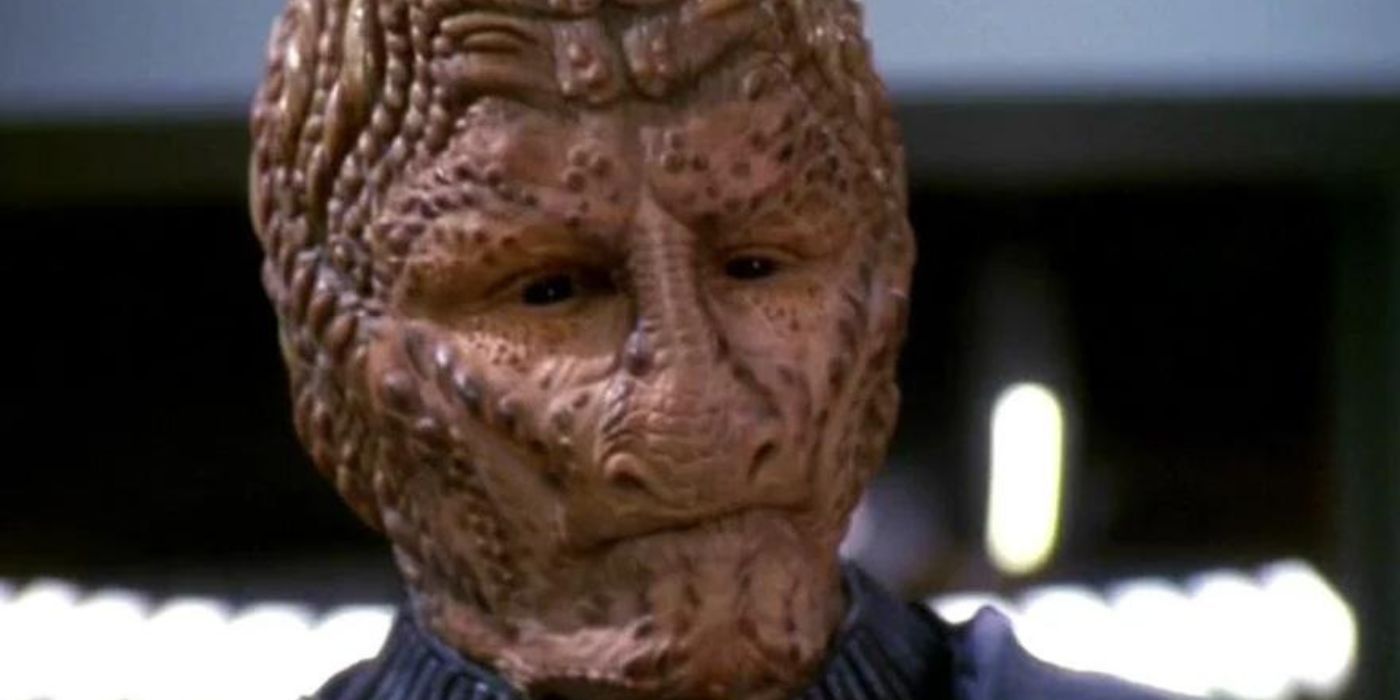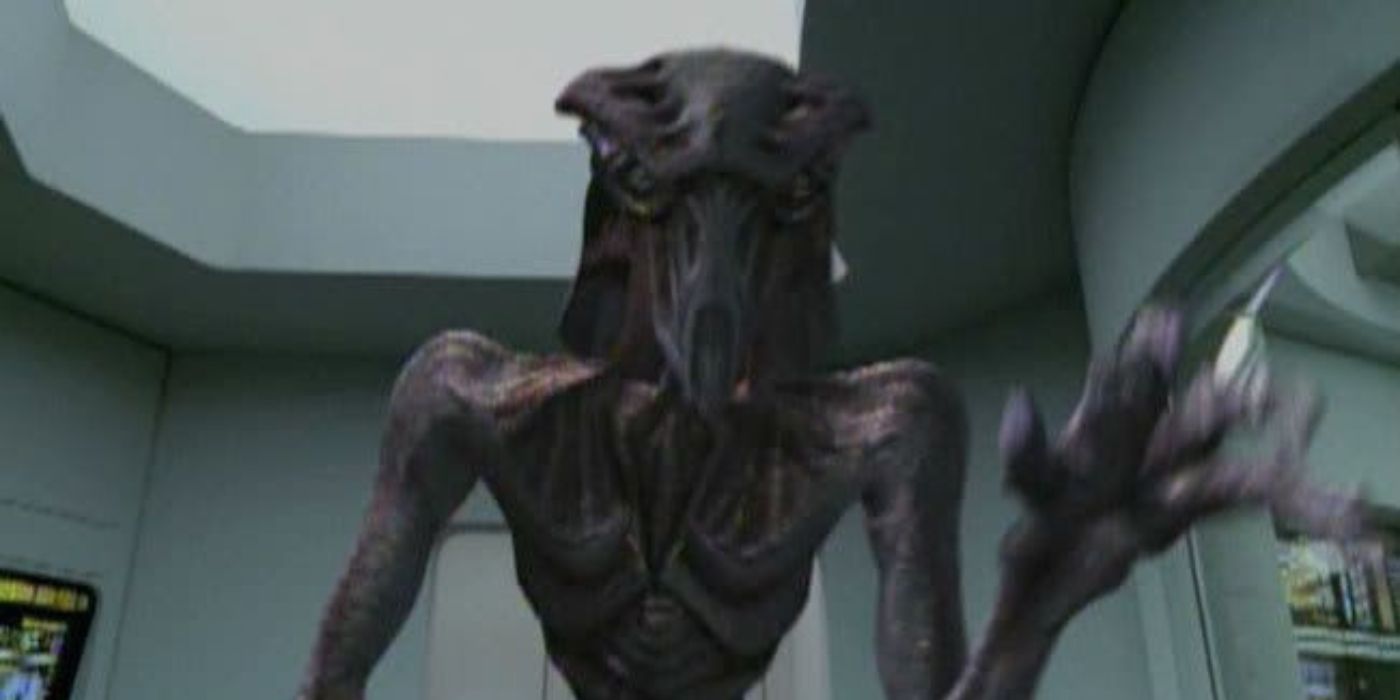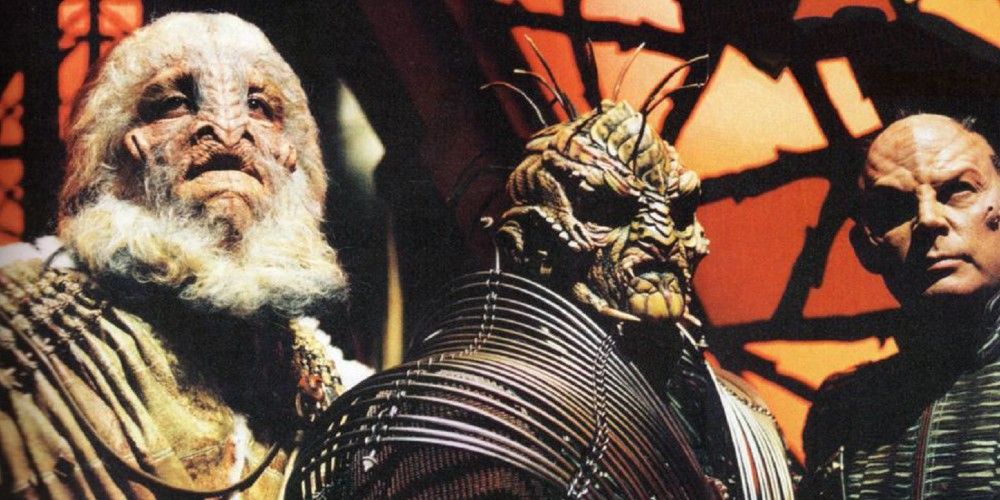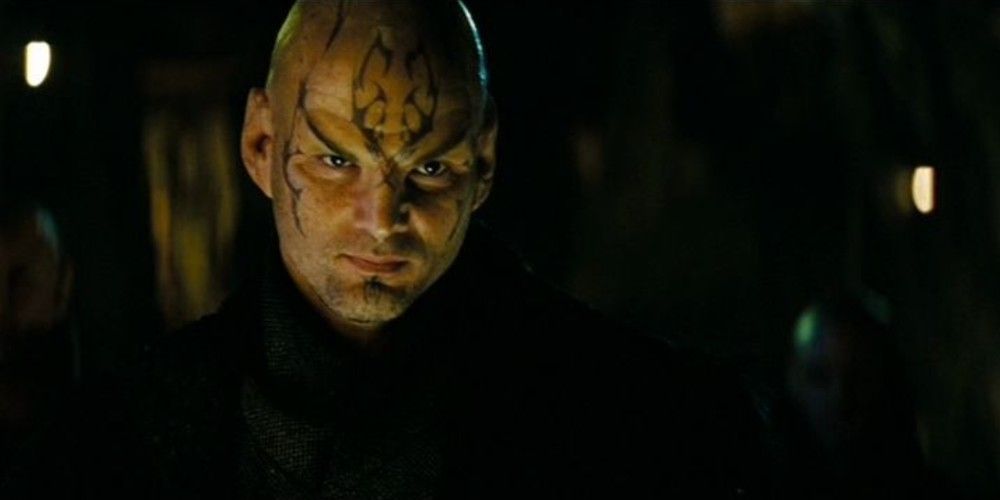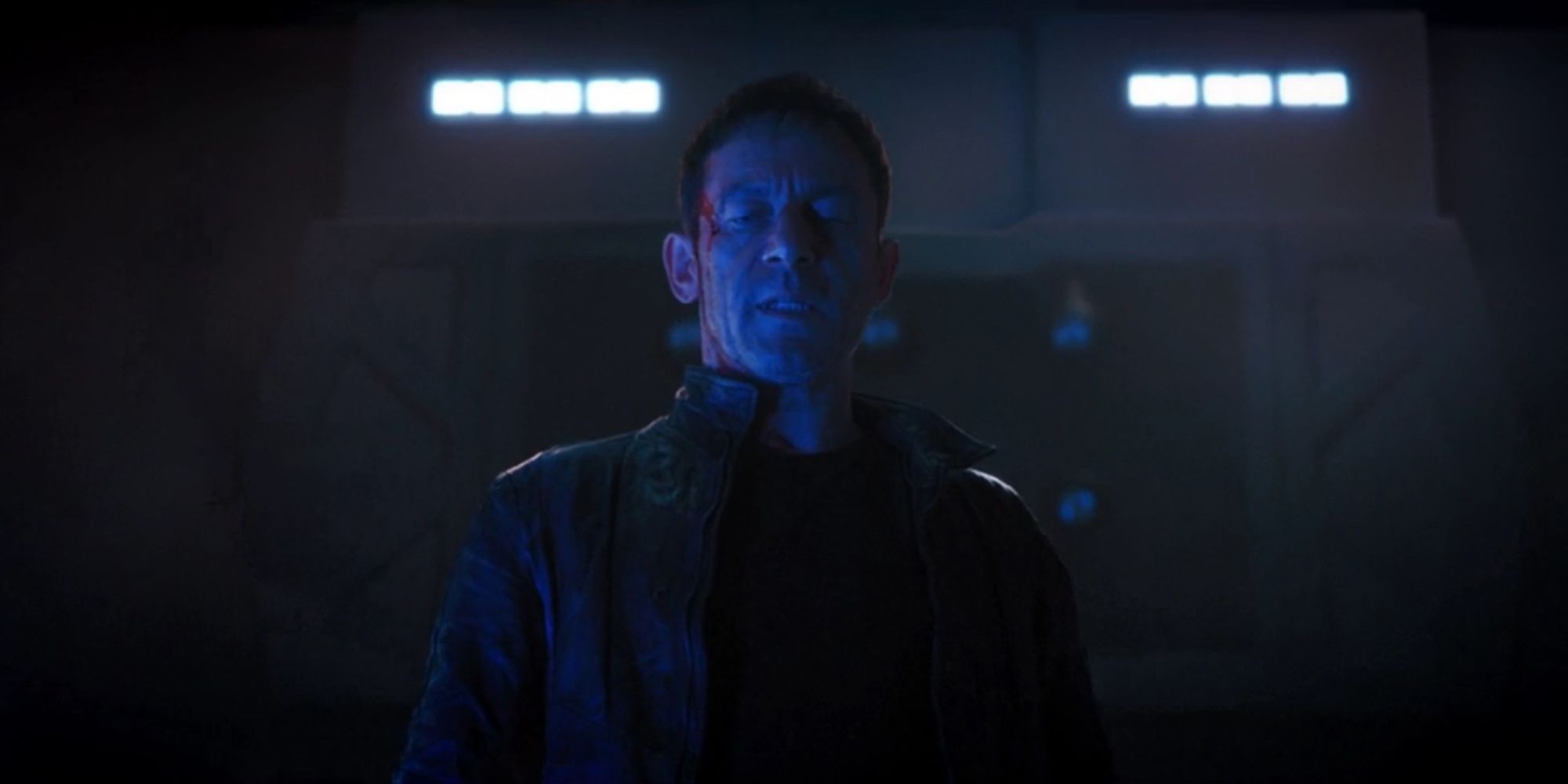The Star Trek universe has grown by leaps and bounds since the first episode aired on September 8, 1966. The fan-favorite series is famous for depicting a future where mankind has come to find peace. Humanity now traveled the stars seeking new life and new civilizations. Star Trek has given the world of pop culture quite a few different heroes. Star Trek is nearly 60 years old, and the science fiction saga created by Gene Roddenberry only lasted this long because of its heroes.
With Star Trek, its villains are often mere ideas, misunderstood alien creatures, or entire races created as a metaphorical allegory. Still, Captain Kirk, Spock, Jean-Luc Picard, or Seven of Nine transcend even their own heroic status when they come face-to-face with a real villain. From Khan Noonien Singh to the nameless Borg, Star Trek's villains may not be as iconic as that other space franchise, but they nonetheless stand apart from the typical threat to the United Federation of Planets. While not every villain has stood out over time, some have become as well-known as Captain Kirk and Mr. Spock. These are the villains that have left an impression not only in the Star Trek universe but in pop culture as a whole. They are presented in chronological order based on their first appearance in the franchise.
Updated on December 30, 2023, by Robert Vaux: The article has been updated to include details on each character and when they appeared in the franchise. The entries have also been reorganized to better rank each villain accordingly.
15 Gary Mitchell Tried To Turn The Captain Kirk Against His Crew
|
First Played by |
First Appearance |
Final Appearance |
Preferred Methodology |
|---|---|---|---|
|
Gary Lockwood |
The Original Series S1, E1 "Where No Man Has Gone Before" |
The Original Series S1, E1 "Where No Man Has Gone Before" |
Enhanced Mental Abilities |
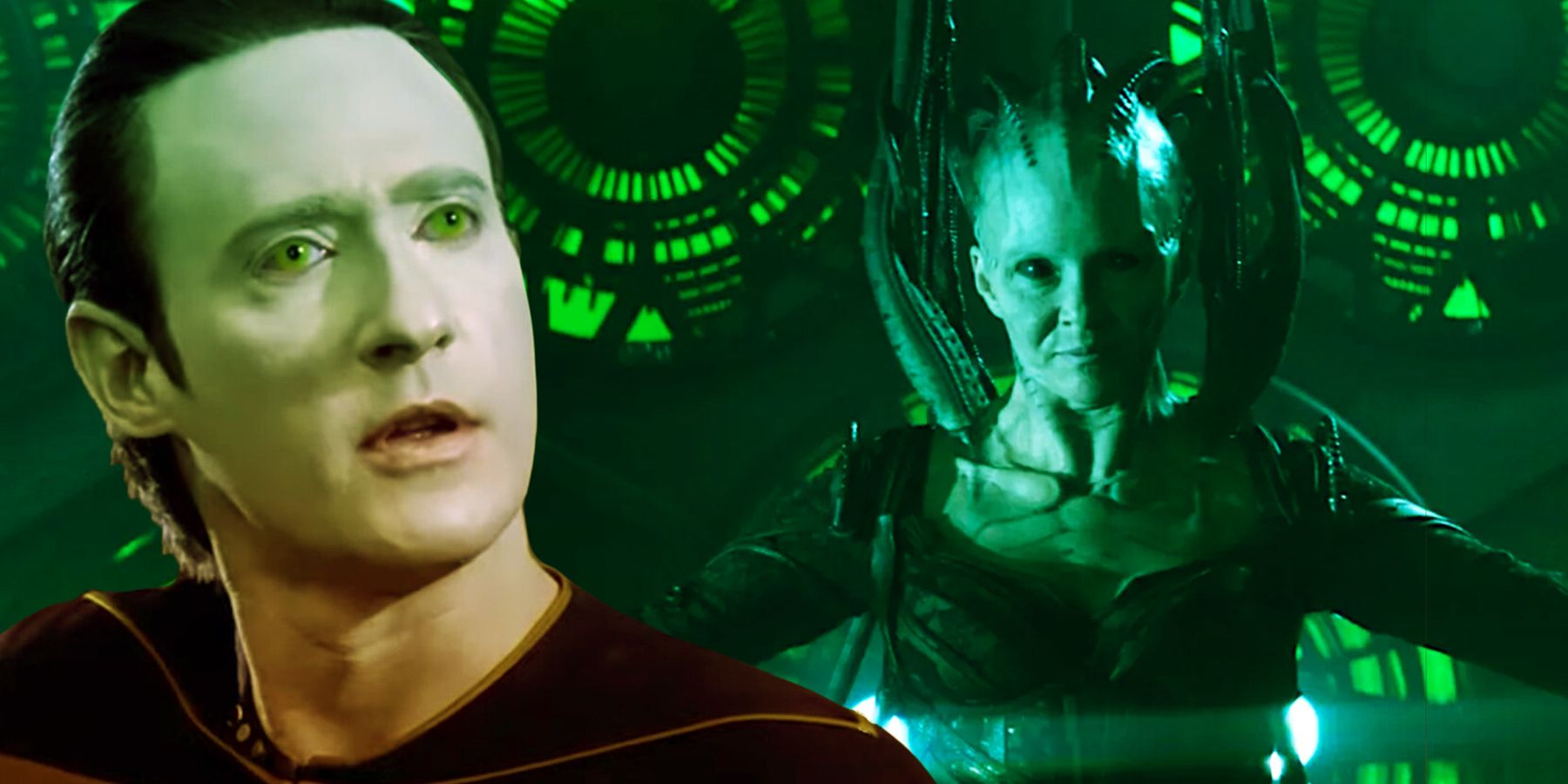
The 30 Most Powerful Star Trek Species, Ranked
Star Trek extends across a vast universe and multiple timelines full to the brim with powerful, and often dangerous, alien species.Gary Mitchell appeared in one of the most memorable episodes of Star Trek: TOS. He started as a close friend of Captain Kirk and the ship's navigator for the USS Enterprise. However, the Galactic Barrier irradiated Mitchell, and he gained supernatural powers. Gary's powers continued to intensify, and as he grew more powerful, he became less human.
Gary Mitchell lost all connection to his humanity, and he put the crew of the Enterprise at risk. He tried to force Captain Kirk to do the one thing no good leader ever wants to do; kill his own crewmate. Gary Mitchell set the standard for what made a good Star Trek villain. He was a character fans rooted against even as they felt for him. This episode was the second pilot for Star Trek: The Original Series. While Captain James T. Kirk proved to be the hero NBC wanted, he needed Gary Mitchell to show them why.
14 The Romulan Star Empire Attacked From The Shadows
|
First Played by |
First Appearance |
Final Appearance |
Preferred Methodology |
|---|---|---|---|
|
Mark Lenard ("Romulan Commander") |
The Original Series S1, E8 "Balance of Terror" |
Ongoing |
Deceit/Martial Conquest |
While the Romulans have never been given the same standing in pop culture as the Klingons, they are arguably even more villainous. The Earth-Romulan War led to the creation of the United Federation of Planets. The secretive Romulans were so elusive that no one saw their faces for over a hundred years. While there have been many dangerous individual Romulans, like Nero, perhaps the most sinister was Picard's Narek. A member of the Zhat Vash, hidden within the Tal Shiar "secret police," he used kindness and empathy as his weapon against Soji Asha, the "daughter" of Star Trek: TNG's Data.
When Romulans first showed up in The Original Series, it shocked everyone to learn that they looked just like Vulcans. The Romulans were an offshoot of the Vulcan race from millennia before the series. They refused to bury their feelings and become purely logical beings, which led them to establish their own society. By the time of the 32nd Century, however, the Vulcans and Romulans reunited thanks to Spock's efforts.
13 Khan Noonien Singh Left Destruction In His Wake
|
First Played by |
First Appearance |
Final Appearance |
Preferred Methodology |
|---|---|---|---|
|
Ricardo Montalban |
The Original Series S1, E24 "Space Seed" |
Star Trek II: The Wrath of Khan |
The Genesis Device |
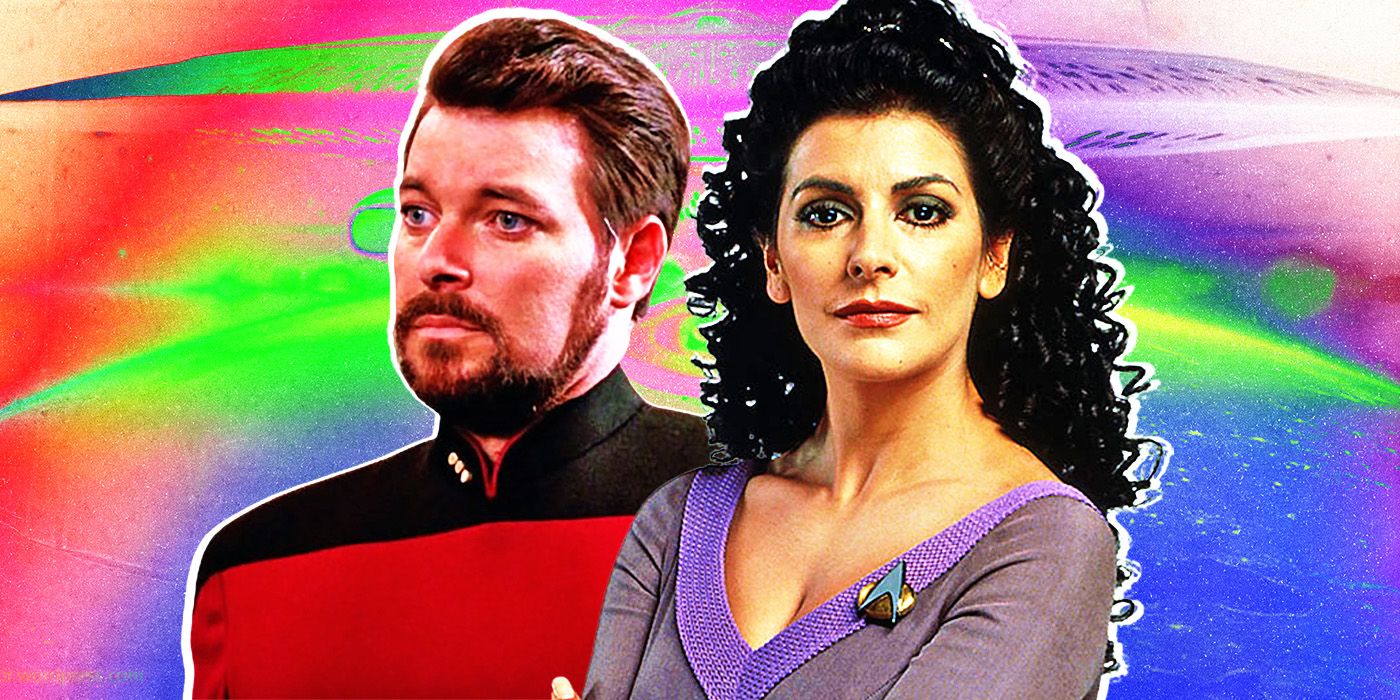
Deanna Troi's Importance to Star Trek: TNG Exceeds Her Romance With Riker
Deanna Troi has a popular romance with William Riker on Star Trek: The Next Generation, but she's fulfilled more important roles on the Enterprise-D.A former ruler of Earth, Khan Noonien Singh was a genetically engineered superhuman who rose to power during the Eugenics Wars. He became Star Trek's greatest villain after he was overthrown and exiled into space. In Star Trek II: The Wrath of Khan, he and his surviving fellow "augments" nearly killed everyone on the Enterprise. To save the ship, beloved character Spock died.
Khan stands out as not only the greatest villain in Star Trek but one of the greatest villains in sci-fi. The Wrath of Khan reinvigorated the Star Trek franchise, leading to a series of sequels and new shows that continue to this day. Khan was such a compelling villain that he was even brought back for the second movie in the reboot trilogy, Star Trek Into Darkness. His descendant, La'an Noonien Singh, serves as the Chief of Security on the Enterprise in Strange New Worlds.
12 The Klingon Empire Was Ruthless And Formidable
|
First Played by |
First Appearance |
Final Appearance |
Preferred Methodology |
|---|---|---|---|
|
Jon Colicos ("Kor") |
The Original Series S1, E27 "Errand of Mercy" |
Ongoing |
Martial Conquest |
One of the best-known alien races from the Star Trek franchise is the Klingons. They started as an allegorical representation of the Soviet Union to Starfleet's America in The Original Series. By the time of Star Trek: TNG, it was revealed that the Klingons made a tenuous peace with the United Federation of Planets. This was set in motion in Star Trek VI: The Undiscovered Country, paralleling the fall of the Soviet Union.
However, Kruge, played by Christopher Lloyd in The Search for Spock, was perhaps the most formidable of all, because he killed Captain Kirk's son, David Marcus. The Federation-Klingon War seen in the first season of Star Trek: Discovery featured the Klingons as one of the greatest foes in Star Trek. Despite the heroic actions of Lt. Cmdr Worf in The Next Generation and Deep Space Nine, Klingons like Kruge and General Chang prove that one can never turn their backs on the Klingons.
11 Q and the Q Continuum Were Over-Powered
|
First Played by |
First Appearance |
Final Appearance |
Preferred Methodology |
|---|---|---|---|
|
Jon de Lancie |
The Next Generation S1, E1, "Encounter at Farpoint" |
Picard S3, E10 "The Last Generation" |
Cosmic Powers |
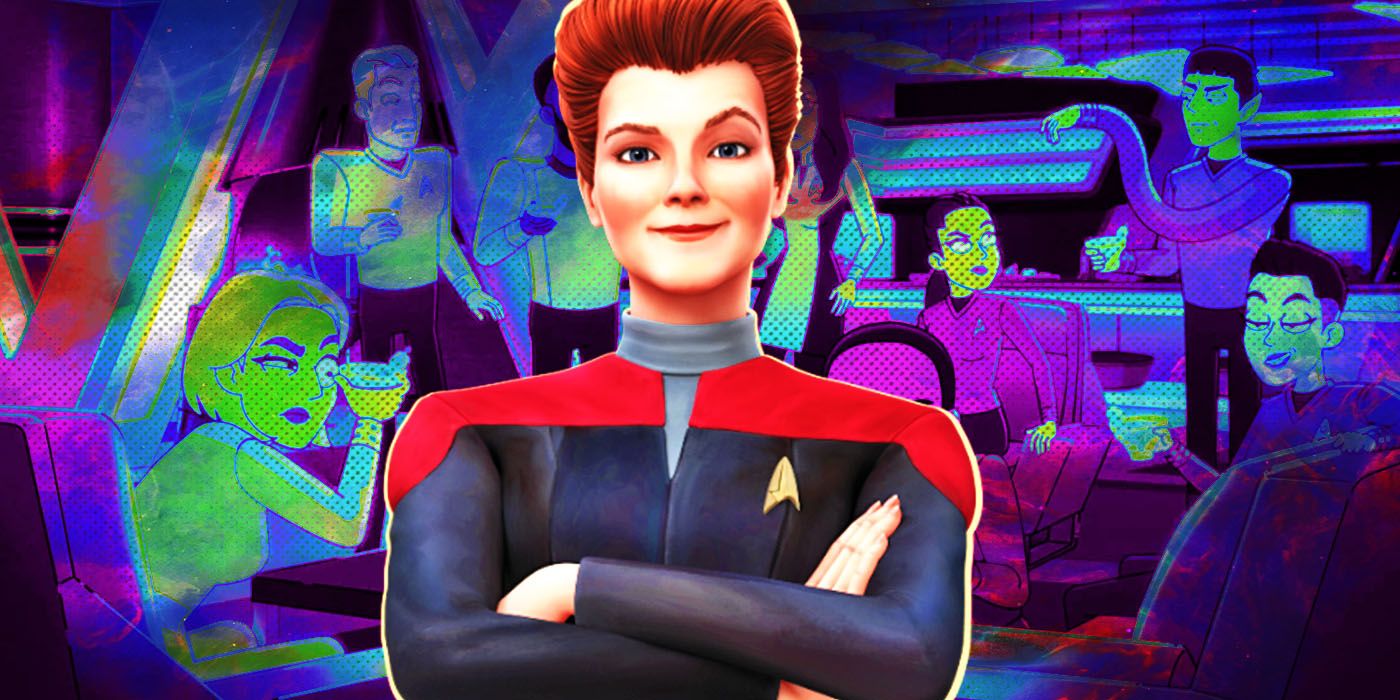
Star Trek: Prodigy Showrunners Tease More Crossovers With Other Trek Shows
Kevin and Dan Hageman discuss the effectiveness of Star Trek "deep cuts" and how Star Trek: Prodigy might adapt its characters in live-action one day.Introduced in Star Trek: The Next Generation, Q is an extradimensional being of unknown origin who appears to have nearly full control over all time and space. He is a member of a continuum of other beings, who also identify as "Q," meant to keep the cosmic balance of the universe. Q takes a specific interest in Captain Jean-Luc Picard and the crew of his Enterprise. He put them on "trial" to see if humanity had overcome their "savage" nature. If Picard failed to convince Q, he would erase humanity from the galaxy.
While many of Q's exploits were fun to watch, it was his actions that first brought the Federation to the attention of the Borg. Q tried to play his games with another of Star Trek's best captains, Benjamin Sisko. He quickly discovered that not every human was as willing to play along with his whims when Sisko punched the omnipotent being. He also frequently visited Captain Janeway on the USS Voyager, including involving her in the Q Continuum civil war that only ended when the fan-favorite Q mated with another of his species.
10 Lore Was A Master Manipulator
|
First Played by |
First Appearance |
Final Appearance |
Preferred Methodology |
|---|---|---|---|
|
Brent Spiner |
The Next Generation S1, E13, "Datalore" |
Picard S3, E8 "Surrender" |
Manipulation and Deceit |
One of the things some fans forget about Data is that he has a brother. Dr. Noonien Soong created Lore, who is a prototype android and the older brother of Lt. Cmdr. Data. He had emotions, but his inability to handle his feelings properly led to Lore becoming a dangerous villain. He believed he was better than humans and other organic lifeforms.
Throughout Star Trek: The Next Generation, Lore believed he was not only superior to living beings but to his brother Data as well. His association with powerful forces like the Crystalline Entity allowed him to manipulate it and turn it towards destruction. Lore would later lead a group of Borg against the crew of the Enterprise. However, his ego would eventually lead to his destruction.
9 Armus Killed Lt. Tasha Yar
|
First Played by |
First Appearance |
Final Appearance |
Preferred Methodology |
|---|---|---|---|
|
Marc McChesney & Ron Gans |
The Next Generation S1, E23 "Skin of Evil" |
Lower Decks S2, E6 "The Spy Humongous" |
Psionic Abilities |
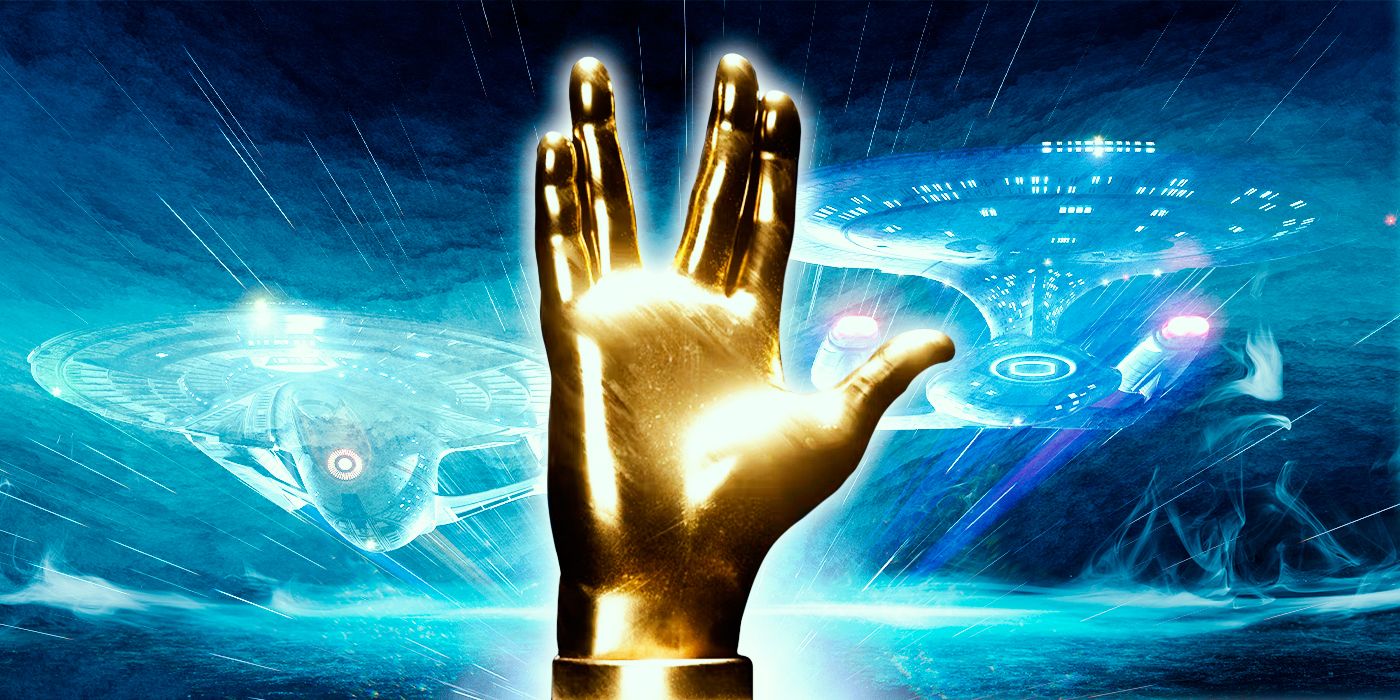
Star Trek's Renaissance Is So Strong, It Has Its Own Awards Show
After decades of being ignored by the Emmys and Golden Globes, the Virtual Trek Con has the LLAPys, an awards show just for the Star Trek franchise.While there were several "redshirts" who died in service to the Enterprise, no member of the main bridge crew was permanently killed off without being resurrected somehow. That all changed in Star Trek: The Next Generation's "Skin of Evil" from the first season. A few of the best members of Star Trek: TNG's away team encountered a powerful being known as Armus.
Armus was a being composed of the discarded evil from an ancient race of alien celestials. He had incredible psionic abilities that he used to strike down Lt. Tasha Yar. She died instantly, and Armus threatened other members of the crew by trapping them inside his inky liquid body. Picard outsmarted Armus and free his crew members, but the damage was done. Denise Crosby, the actor who played Yar, wanted to leave the series during its tumultuous first season. However, she would return in "Yesterday's Enterprise" and "Unification I & II."
8 The Borg Queen Led A Conquering Army
|
First Played by |
First Appearance |
Final Appearance |
Preferred Methodology |
|---|---|---|---|
|
Alice Krieg |
Star Trek: First Contact |
Picard S3, E10, "The Last Generation" |
Assimilation |
One of the most dangerous enemies from Star Trek: TNG was the Borg. They were a hivemind of cyborgs that hoped to wipe out all living things in the universe and replace them. The Borg go from planet to planet, assimilating the alien races they come across and turning them into Borg. They also used up the resources of the planets to fuel their evolution and power their ships.
The Borg Queen led the Collective when they threatened the Enterprise in Star Trek: First Contact. The only true threat to the Borg was the Federation, and they even attempted to assimilate Earth in the past to erase its place in history. The Borg were ultimately defeated by a one-two punch (separated by 25 years) from Captains Picard and Janeway. In the Voyager series finale, a time-traveling Admiral Janeway poisoned the collective while also using them to get the lost ship back to the Alpha Quadrant. In Picard Season 3, the Borg made a last-ditch attempt to assimilate Starfleet but were defeated by the crew of the USS Enterprise NCC-1701-D.
7 The Cardassian Empire Had A Violent History Of War And Oppression
|
First Played by |
First Appearance |
Final Appearance |
Preferred Methodology |
|---|---|---|---|
|
Marc Alaimo ("Macet") |
The Next Generation S4, E12 "The Wounded" |
Ongoing |
Martial Conquest |
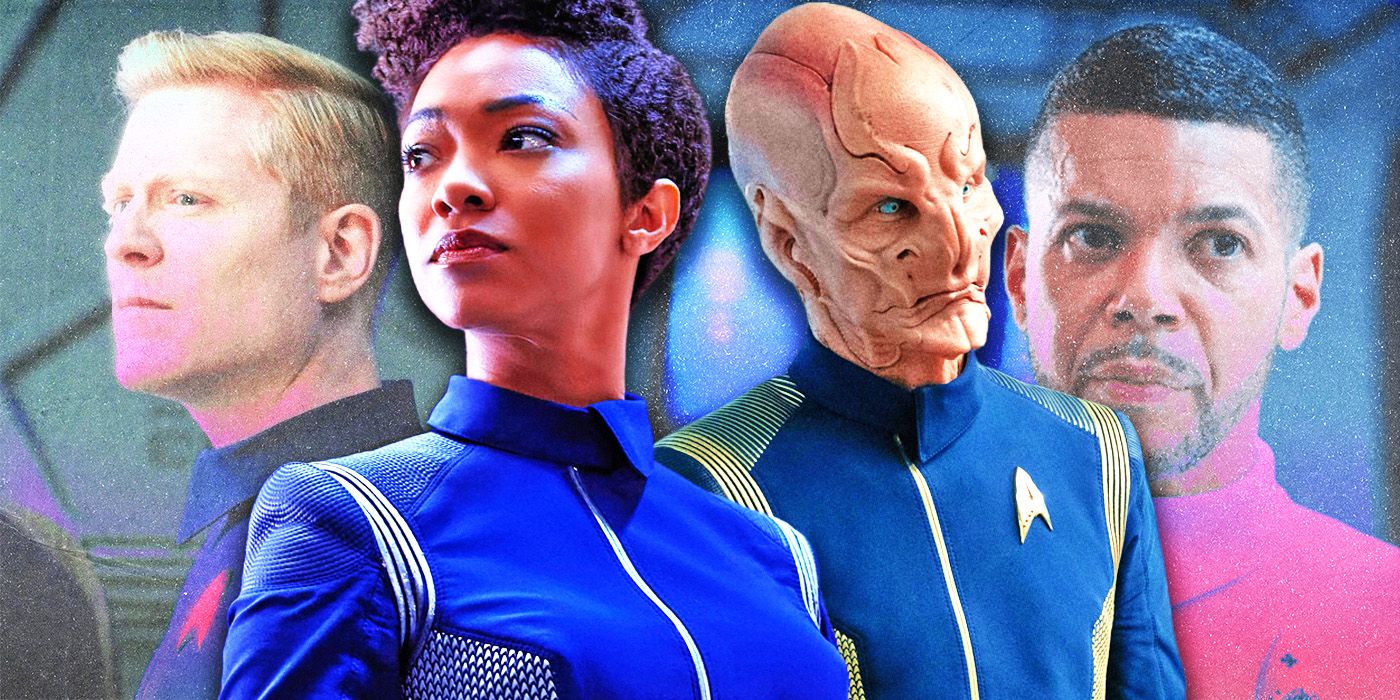
How Many Ongoing Love Stories Does Star Trek: Discovery Have?
The final Star Trek: Discovery season will have to cover a lot of ground, including giving satisfying endings to the show's many ongoing love stories.Star Trek: The Next Generation introduced a few new alien species who would become lasting threats to the Federation. The Cardassians were a xenophobic race of aliens involved in quite a few violent skirmishes over territory. They also occupied the planet of Bajor and committed several atrocities before the enslavement ended. Ensign Ro Laren was the first recurring Bajoran character, until Major Kira Nerys became Benamin Sisko's first officer on the Deep Space Nine station, originally built by the Cardassians to further oppress Bajor.
There were a few memorable Cardassian soldiers who left a lasting impression on fans. Gul Madred captured and psychologically tormented Captain Picard in "Chain of Command." The former head of Deep Space Nine was Gul Dukat, who was responsible for war crimes against the Bajoran people. If Deep Space Nine had a central villain, it was Gul Dukat, who ultimately met his end along with Captain Sisko in the series finale.
6 The Changelings and the Dominion Sought Power
|
First Played by |
First Appearance |
Final Appearance |
Preferred Methodology |
|---|---|---|---|
|
Salome Jens ("Female Changeling") |
Deep Space Nine S3, E1 "The Search" |
Picard S3, E10 "The Last Generation" |
Martial Conquest |
While Captain Picard's biggest problems were Q and the Borg, Captain Sisko and the crew of Deep Space Nine had to deal with the Dominion. Hailing from the Gamma Quadrant, the Dominion was essentially an evil version of the United Federation of Planets. Made up of hundreds of races, the Dominion looked to expand past the Gamma Quadrant using the Bajoran Wormhole. Called "the Founders" by other Dominion races, a character known only as "the female changeling" led their war effort.
The Dominion War lasted two years and became one of the deadliest wars in Federation history. It only ended when a secretive faction of Starfleet, known as Section 31, created a deadly plague. It threatened to wipe out the shape-shifting alien race known as the Founders, who led the Dominion. Odo, the constable of Deep Space Nine, was a changeling who didn't know his history. In their liquid state, changelings can "join." He administered the cure first to the female changeling and then, in the series finale, returned to their home, the Great Link, to cure the rest of his species. Little is known about what happened to other Dominion races.
5 The Hirogen Were Blood-Thirsty Hunters
|
First Played by |
First Appearance |
Final Appearance |
Preferred Methodology |
|---|---|---|---|
|
Tiny Ron ("Idrin") |
USS Voyager S4, E14, "Message in a Bottle" |
USS Voyager S7, E10 "Flesh and Blood, Part II" |
Hunting Sentient Species |
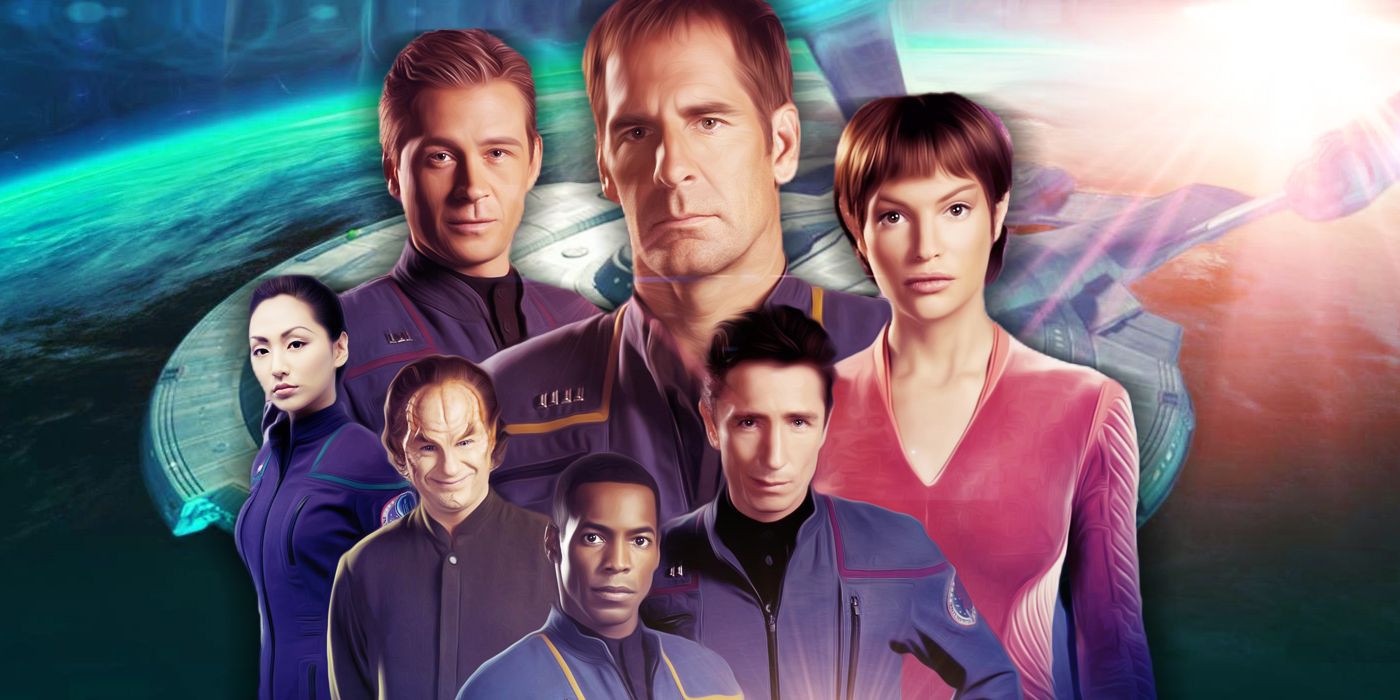
This Underrated Star Trek Series Has the Franchise's Best Pilot
The first episode of any series starts the story without being fully formed, yet the pilot episode of Star Trek: Enterprise is the franchise's best.A species of hunters, The Hirogen harried the USS Voyager as they attempted to return to Federation space. Wanting the Voyager and her crew as trophies, various groups of the Hirogen attacked the lost ship numerous times throughout the series. With their insatiable need for the hunt, the Hirogen proved one of Voyager's toughest challenges.
The encounters varied from one or two of the crew coming across the Hirogen to a two-part episode where some Hirogen, including Alpha Karr and his second Turanj, capture the ship. They force the brainwashed crew into performing various scenarios on the Holodeck, including a version of German-occupied France. When Captain Janeway successfully negotiated a cease-fire with Karr, Turanj killed him and tried to continue hunting the crew.
4 'Boothby' and Species 8472 Could Impersonate Others To Get Their Way
|
First Played by |
First Appearance |
Final Appearance |
Preferred Methodology |
|---|---|---|---|
|
Ray Walston |
USS Voyager S3, E26 "Scorpion, Part I" |
USS Voyager S5, E4 "In the Flesh" |
Biotechnology |
Despite only appearing in a few episodes, Species 8472 was one of the most dangerous enemies the Voyager ever faced. Hailing from another dimension known as "fluidic space," Species 8472 used a form of biotechnology for the ships and weapons. After their first entry into the dimension Star Trek heroes occupy, they set up a holographic Starfleet headquarters as a reconnaissance operation, including duplicating legendary Academy groundskeeper Boothby, played by the late Ray Walston.
Initially, they posed such a threat that it took an uneasy alliance between the Voyager and the Borg to defeat them, bringing Seven of Nine into the crew. Yet, Captain Janeway learned Species 8472 wasn't as aggressive as the Borg claimed. Rather, the Borg tried to assimilate them, and they assumed all creatures in the galaxy were like the Borg. The member of Species 8472 who impersonated Boothby was a threat but not unreasonable. He later told Janeway he would try to convince his fellows to not invade the Milky Way.
3 The Xindi Murdered Millions Of Humans During Their Attack On Earth
|
First Played by |
First Appearance |
Final Appearance |
Preferred Methodology |
|---|---|---|---|
|
Rick Worthy ("Jannar") |
Enterprise S2, E26, "The Expanse" |
Ongoing |
Superweapons |
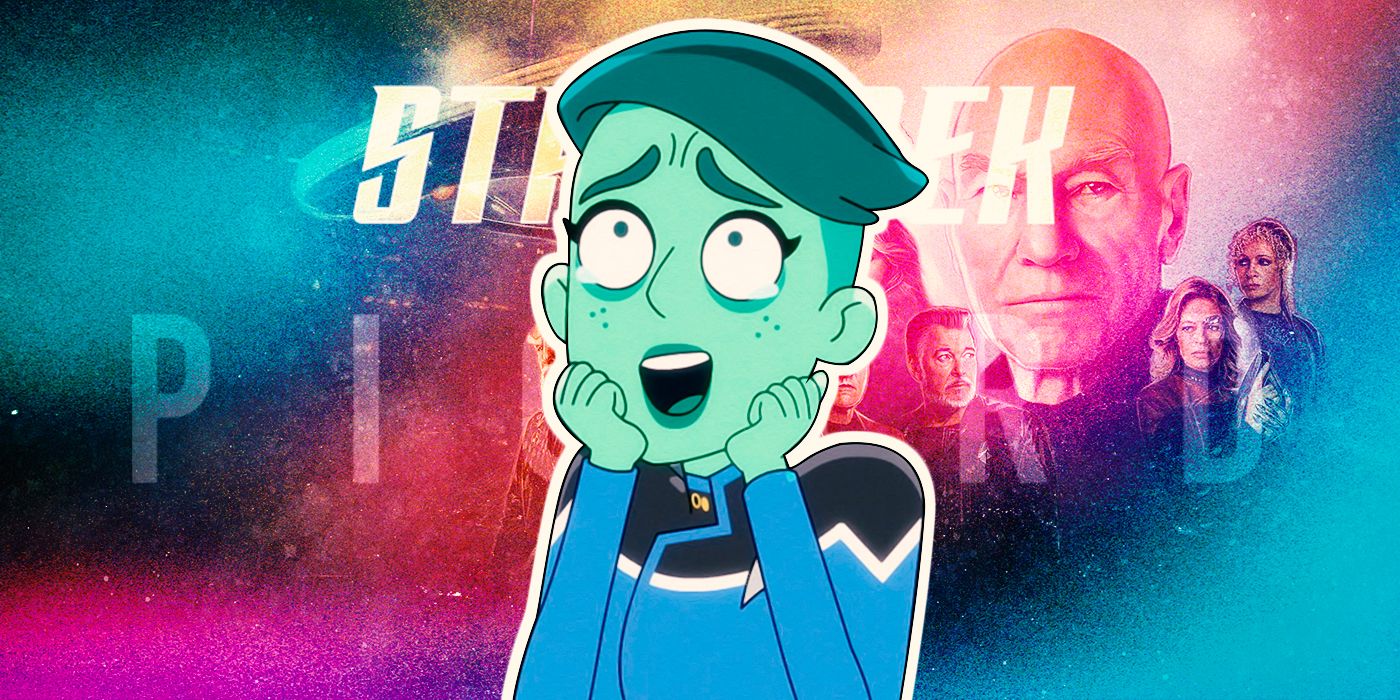
The Best Star Trek Legacy Character Returns in 2023
The end of 2023 brings a big year for Star Trek to a close, including the return of fan-favorite and obscure legacy characters to the new series.The Xindi were a species made up of a collective of six alien races located in the Delphic Expanse. There were the humanoid primates, the ape-like aboreals, an insectoid race, an aquatic race, and the militant, villainous reptilians. The main villains in the third season of the controversial Star Trek: Enterprise, the Xindi sent a superweapon to Earth after hearing that Starfleet planned to destroy them, designed by primate scientist Degra.
The Xindi superweapon killed seven million people and left a scar stretching from Florida to Venezuela. The Xindi stand out as the only enemies in all of Star Trek — besides humans, of course — who have caused serious damage to Earth. After being captured and deceived by the NX-01 Enterprise crew, Degra realized the Xindi had been duped by another alien race from another dimension. They built spheres throughout the Delphic Expanse meant to "terraform" the galaxy so their people could live in it. Only after the Xindi and humanity united were the Sphere-Builders defeated.
2 Nero Destroyed The Planet Vulcan
|
First Played by |
First Appearance |
Final Appearance |
Preferred Methodology |
|---|---|---|---|
|
Eric Bana |
Star Trek (2009) |
Star Trek (2009) |
Time Travel and Future Tech |
Introduced in the 2009 Star Trek reboot, Nero was a Romulan, one of the greatest adversaries of Star Trek's Federation. Nero blamed Spock for the destruction of the Romulan homeworld. Nero traveled 129 years into the past, which allowed him to use his superior technology to attack the USS Kelvin, a Federation ship on which James T. Kirk's parents were stationed. He and his mother lived, while his father died with the ship.
This created the "Kelvin Timeline" an alternate reality like the Mirror Universe, but one where different versions of Kirk, Spock, McCoy, and the rest lived "new" lives. One of Nero's most villainous acts was using implosive "red matter" to destroy the planet Vulcan. Nero's actions set the course for the new Star Trek films, while the current TV shows continued in the original timeline. Later, Star Trek: Picard revealed the destruction of Romulus had lasting consequences there as well.
1 Captain Gabriel Lorca Used His Position To Manipulate His Crew
|
First Played by |
First Appearance |
Final Appearance |
Preferred Methodology |
|---|---|---|---|
|
Jason Isaacs |
Discovery S1, E3, "Context is for Kings" |
Discovery S1, E13 "What's Past Is Prologue" |
Duplicity and Subterfuge |
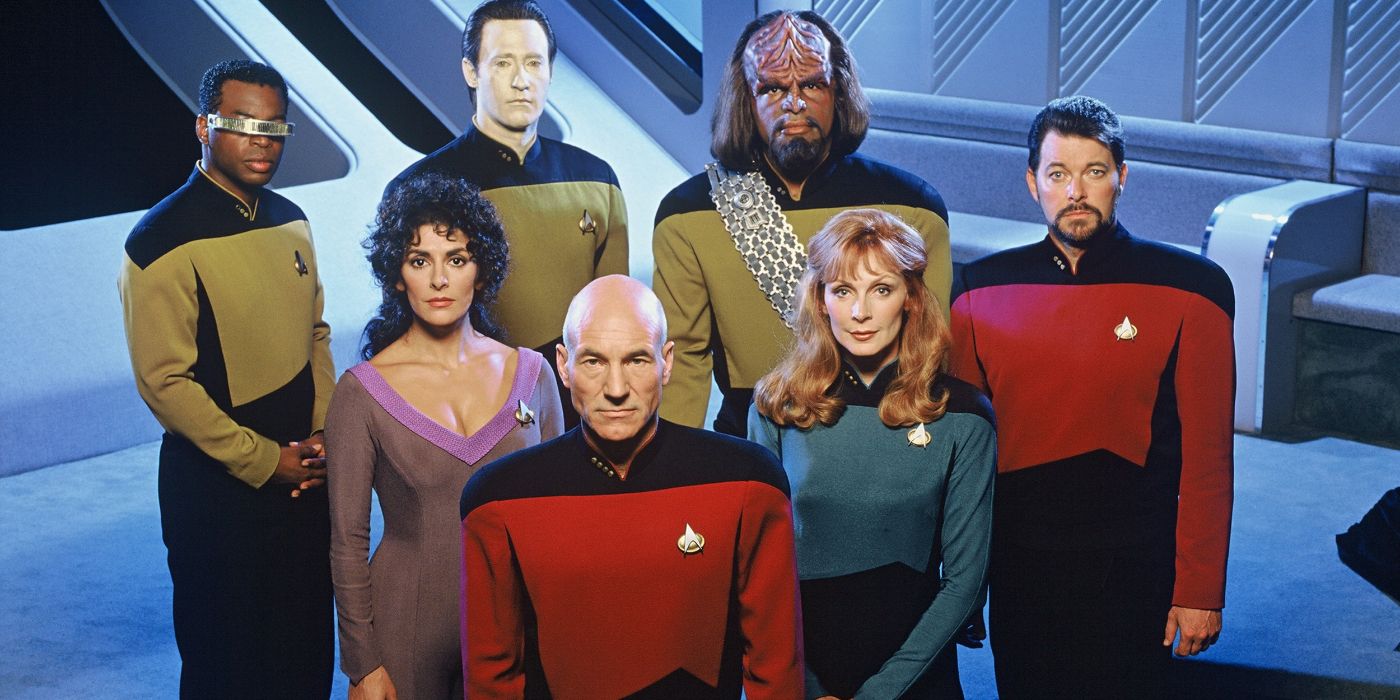
Why Star Trek: TNG Struggled Its First Two Seasons
Star Trek: The Next Generation was a gamble that almost didn't pay off due to the show facing many challenges behind-the-scenes in its early seasons.Star Trek: Discovery introduced the titular new ship and its captain, Gabriel Lorca. He recruited Michael Burnham to his crew and manipulated his mission orders to take the Discovery to another reality. Lorca was secretly from the Mirror Universe, a dark alternate reality that first appeared in The Original Series, and was revisited in both Deep Space Nine and Enterprise. He's become something of a standard-bearer for the concept, which the franchise periodically returns to in order to explore its protagonists' dark sides.
Lorca was a traitor who turned on the Terran Emperor in the Mirror Universe. He escaped punishment by accidentally traveling to another reality. Lorca took the place of his counterpart, using his rank in Starfleet to get assigned to the one ship that could take him home. Lorca was conniving and determined, but still a captain who could inspire his crew. He was a dangerous enemy, emblematic of the third wave of Star Trek.
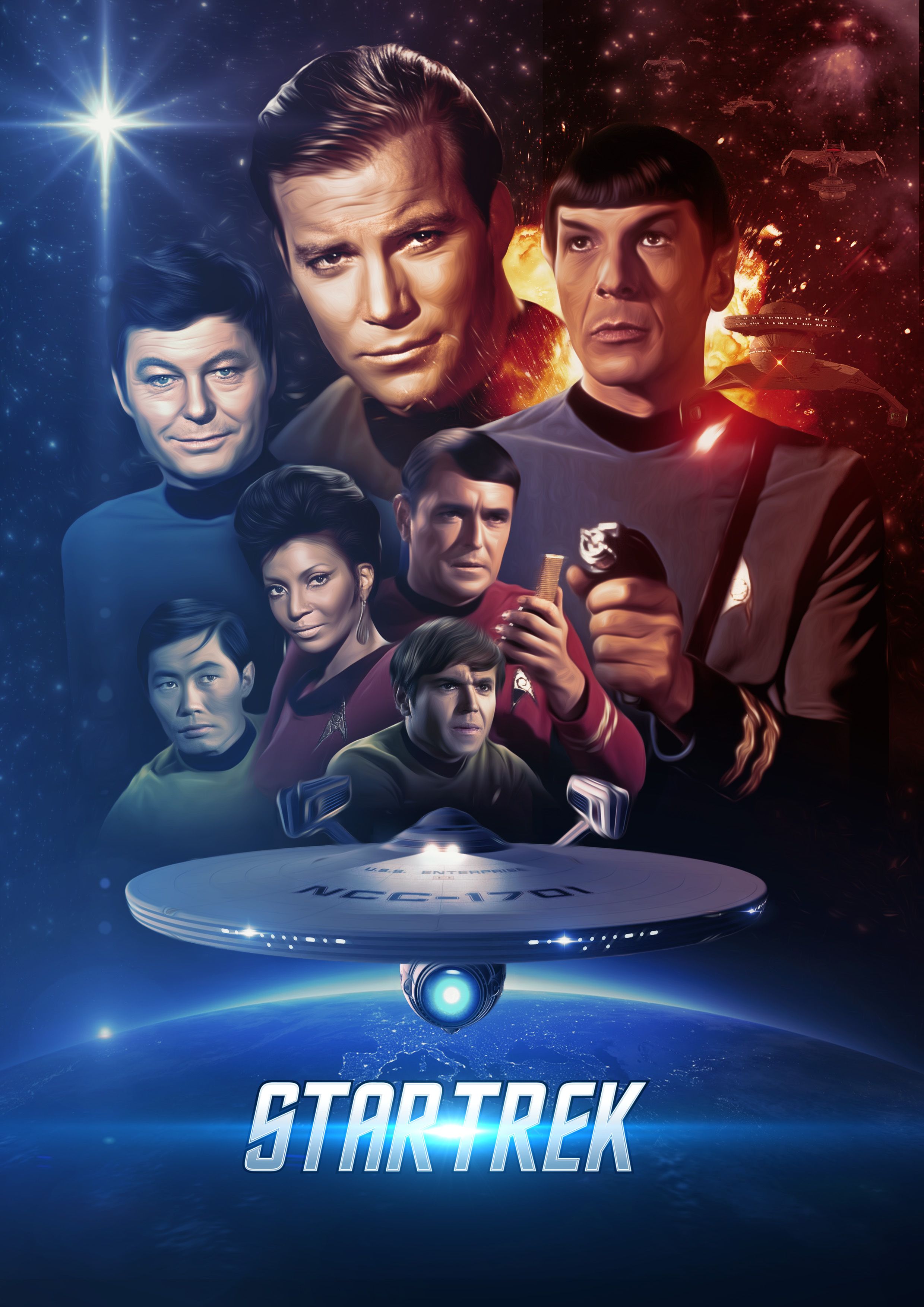
Star Trek
The Star Trek universe encompasses multiple series, each offering a unique lens through which to experience the wonders and perils of space travel. Join Captain Kirk and his crew on the Original Series' voyages of discovery, encounter the utopian vision of the Federation in The Next Generation, or delve into the darker corners of galactic politics in Deep Space Nine. No matter your preference, there's a Star Trek adventure waiting to ignite your imagination.

